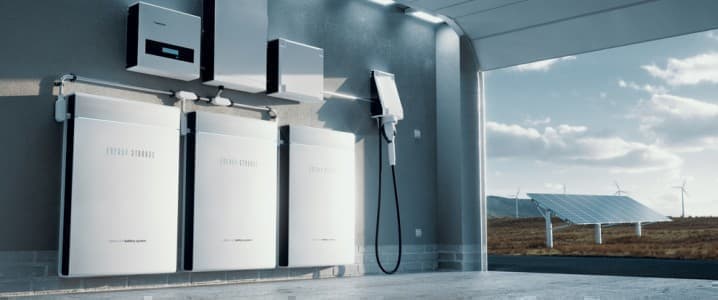
They have created a new battery that could have profound implications for the large-scale energy storage needed by wind and solar farms. Jiang envisions a future where every house is powered by renewable energy stored in batteries.
Jiang noted that innovations such as UC’s will have profound effects on green energy. Batteries store renewable energy for when it’s needed, not just when it’s produced. This is crucial for getting the most out of wind and solar power, he said.
By comparison traditional lead acid car batteries contain a mix of sulfuric acid and water. And while they are inexpensive and made from readily available materials, they have severe drawbacks for industrial or large-scale use. They have a very low energy density, which isn’t useful for storing megawatts of power needed to power a city.
Crucially they have a low threshold for electrochemical stability. Jiang said that means they can blow up. “Water has a voltage limit. Once the voltage of an aqueous battery exceeds the stability window of 1.5 volts, the water can decompose or be split into hydrogen and oxygen, which is explosive,” he said.
So Jiang and his students have developed a battery without water that can generate nearly 4 volts of power. Jiang’s novel design does so without a membrane-separator, which are among the priciest parts of these kinds of batteries, he noted.
“Membranes are super expensive,” Jiang said. “We developed a new type of energy storage material that improves performance at a lower cost.” Likewise, membranes are inefficient, he added. “They can’t separate the positive and negative sides completely, so there is always crossover.”
The group has submitted provisional patent applications.
“There is still a long way to go,” Jiang said. But he said we are hurtling toward a battery revolution in the next 20 years. “I am confident about that. There is a lot of intense research going into pushing the boundaries of battery performance.”
His students are equally enthusiastic. Doctoral student and study co-author Rabin Siwakoti said the battery offers higher energy density. “So even a small battery can give you more energy,” he said.
Co-author and doctoral student Jack McGrath added, “We’ve managed to eliminate the membrane in a battery, which is a huge component of upfront costs. It’s as much as 30% of the cost of the battery.”
Co-author Soumalya Sinha, a visiting professor at UC, said countries are racing to develop cheaper, more efficient batteries. “This design significantly decreases material costs,” he said. “We’re trying to achieve the same performance at a cheaper cost.”
Other contributors include lead author and UC postdoctoral researcher Rajeev Gautam, doctoral student Xiao Wang and UC doctoral graduate Amir Lashgari.
This technology might have substantial legs as time goes by. There is a need for huge storage where the politics and social pressures demand intermittent wind and solar instead of power on demand systems.
That could push this along, but the 4 volt operating, non-combustible chemistry, and huge capacity potential, at low cost just might be a set of attributes for other ideas. As it develops, we’ll learn more.
For now the enthusiasm out shines the finer details. Your humble writer almost didn’t make the post as the basic details just aren’t there But it turns out the paper is open access after all. The details are quite interesting!
Congratulations to this team. This looks a home run coming off the bat.
